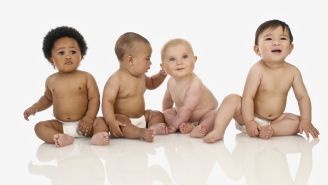Being a twin, triplet or quadruplet is a fascinating and unique experience, says OBGYN Jessica Shepherd, MD, an assistant professor of clinical obstetrics and gynecology at the University of Illinois at Chicago. We asked Dr. Shepherd to share some of the most surprising facts about twins and multiples.
Twins can be different races
“As we know, not all twins are born alike," she says. "Some are fraternal, and others are identical. They can share one or have multiple placentas and amniotic sacs.” But did you know that twins could actually be two different races?
The rare phenomenon is called heteropaternal superfecundation. It can happen if a woman releases more than one egg during ovulation and has sex with two male partners during that time frame. In this situation, one man’s sperm fertilizes one egg while the other man’s sperm fertilizes the other egg. Although uncommon, the races of the babies could differ because each egg is fertilized by different sperm.
Twins have stopped multiplying
“The rate of twin births in 2009 was 76 percent higher than it was in 1980, which is due to mothers waiting longer before they decided to conceive and also due to the increase in fertility treatment options,” says Shepherd. “[Twins] reached a record high in 2014; that is a record 33.9 twins born for every 1,000 births,” she adds.
But between 2014 and 2018, after decades of increases, the twin birth rate dropped 4 percent to a rate of 32.6 per 1,000 births. According to the Centers for Disease Control and Prevention (CDC), the decline occurred in women age 30-plus and white women; the rate for Hispanic and non-Hispanic black women remained relatively unchanged. While reasons for the shift aren’t known for sure, it’s likely due to advancements in fertility treatments. To note: Twins are still much more common now than in 1980.
What about triplets and higher-order multiples? While their births rose significantly during the 1980s and 1990s, they declined by roughly 41 percent between 1998 to 2014. Why? It may be due to changes in IVF therapies and assisted reproductive technologies (ART) practices, which reduced the number of embryos transferred during a procedure.
Expecting twins or multiples? You might notice these symptoms
Sometimes, early in pregnancy, women may experience certain symptoms that indicate twins or more multiples. These possible symptoms may include:
- Elevated hCG levels, known as the pregnancy hormone. It’s the hormone in your blood or urine that shows if you’re pregnant.
- Measuring larger for gestational age, especially early in the second trimester.
- Excessive morning sickness due to the elevated amounts of hCG, the pregnancy hormone.
For expectant mothers of twins or multiples, vaginal bleeding is more common during early pregnancy, with up to 30 percent of women reporting the symptom.
Twins are often born prematurely
A full-term pregnancy is one that lasts between 39 weeks and 0 days, and 40 weeks and 6 days, according to the American College of Obstetricians and Gynecologists.
“With twins, delivery is most times premature, before 37 weeks, and that decreases with each additional baby,” says Shepherd. “For triplets, pregnancies usually end by 33 weeks, and quad pregnancies at 29 weeks.”
Twins can form their own “language”
Many parents of twins note that their children seem to develop their own secret language, also known as idioglossia or cryptophasia. Experts still aren’t sure how it happens, but current thinking is that twins pick up each other’s mispronunciations as they’re learning to talk. For example, if one twin has delayed speech development and has trouble articulating certain sounds or words, the other may mimic their sibling. Since they spend so much time together, twins also tend to make up their own shorthand ways of communicating. Interestingly, researchers have studied certain pairs of twins who were isolated growing up and developed true, fully formed languages of their own.






